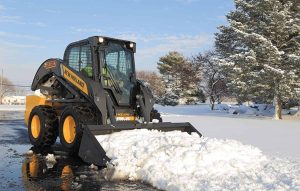Winterize Equipment for Storage Now, Be Ready to Roll in the Spring
If you’ll be using your heavy equipment throughout the winter, it’s important to make sure all the working parts are properly protected against extreme cold, snow, and ice. That way you can keep working as planned instead of dealing with avoidable damage and downtime. But what if you’re not working this winter? Or you’ll only be using some of your fleet or accessories?
You can’t simply park it and forget it and expect that all will be well when spring rolls around. If you do, you’re likely to find yourself grounded and facing expensive repairs instead of getting an early start on the new revenue season.
Preventive storage saves time and money
These tips will help you store equipment so that it is properly protected:
 Drain all fluids and dry water or fluid compartments as best you can to reduce the possibility of freezing. Drain the fuel, too — running the engine while draining the diesel will help you get it all.
Drain all fluids and dry water or fluid compartments as best you can to reduce the possibility of freezing. Drain the fuel, too — running the engine while draining the diesel will help you get it all.- Remove attachments and the battery and store them at room temperature. If buckets or blades cannot be stored where it’s warm, place them on a raised surface rather than bare ground.
- Lubricate machines and accessories. A high-viscosity lubricant will coat everything better and won’t drip off.
- Park machines under cover if possible – even a tarp will help.
- Park wheeled equipment on wooden planks so tires won’t freeze to the ground and become damaged.
- Put a tag or some other identification on each machine that clearly indicates it is not available for winter use. You don’t want someone to inadvertently fire up an unprepared engine.
Following these simple steps to winterize equipment will keep you from wasting time over the winter trying to fix problems that could have been prevented. In the spring, you can thoroughly inspect each piece of equipment and accessory, replace anything that becomes damaged from the cold, replenish fluids and lubricants, and you’ll be ready to roll.
